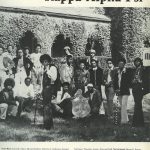Written by Nick Hopkins
African-American students at Illinois have been a statistical minority since the early days of the University. Black students constituted a small fraction of the student population, but contribute a distinct diversity of culture and ideas to the campus community. The Black Greek Letter Association (BGLA), a council of African American fraternities and sororities, is a memorable example of student life and culture on campus. Registered as student organization on December 2, 1972, the BGLA’s mission statement was “To promote black greek unity of organization” and “To improve the quality of social life on the U of I campus.”[1] While the organization did not always see eye-to-eye with various sections of the University, it has certainly accomplished its mission of nurturing a space for greek activities on campus for African American students. Its offspring, the Black Greek Council, exists today as an important section UIUC’s greek social scene.

For as long as black students have attended UIUC they have participated in social and recreational activities. Notable examples include William Walter Smith who graduated in 1900 and was a member of the football team[2] and Clarice Davis Presnell , the first African American homecoming queen (1952) and Alpha Kappa Alpha sorority member.[3] Black sororities and fraternities have existed at UIUC since the former half of the 20th century. However, despite the presence of black students on campus, the University and surrounding community did not provide a hospitable environment for American American students.
Joy Ann Williamson’s book Black Power on Campus: The University of Illinois gives a thorough description of the different University experiences of African American students, as well as the first University initiative to support student diversity. The Special Educational Opportunities Program, known colloquially as Project 500, aimed to increase the number of African American, Latino, and economically disadvantaged students to a level proportional to the national population.[4] The program offered students scholarships and academic counseling, setting the goal of enrolling 500 students for the Fall 1968 school year.[5]

While over 500 students were admitted, the program did not succeed as planned, and many consider it a failure in the long run. When the first group of Project 500 students arrived, some did not have dorm rooms waiting for them. In addition, many local landlords would only rent to white people.[6] Cartoons in black student publications such as Drums, Watu, and the Black Rap illustrate the ostracization and economic constraints that the students felt. Not surprisingly, membership in the Black Student Union and black greek organizations grew significantly at this time.
It was the policy of the Special Educational Opportunities Program administrators that freshmen Project 500 students not participate in black greek organizations or any of their events.[7] Some students did anyway, as black fraternities and sororities provided a sense of community, social events, and, for some, housing.

The BGSA coordinated the events of 10 black greek organizations and provided platform of communication. They also sponsored dances, ice skating events, and the annual black homecoming queen pageant.[8] These gatherings were quite popular, but created tension with the University administration. Many African American students had ties with the black community in Champaign-Urbana (and vice-versa) and many community youth attended the events.[9] This community involvement was unpopular with University administrators, who thought dances should have identification policies, and threatened to bar the BGLA from sponsoring dances altogether in 1980.[10]

In 1978, the Black Greek Letter Association’s missions statement was “To improve the quality of black social life on campus.”[11] This came at a time when racism was felt widely by black students, and coincided with the influx of Project 500 students. The BGLA was one of a few social spaces exclusive to black students and is an important part of the history of student life and culture at the University of Illinois.
[1] Black Greek Association registration card, 1972, Student and Faculty Org. Constitutions & Registration Cards, 1909-2002, Record Series 41/2/41, Box 4, University of Illinois Archives.
[2] Illio, 1901, University of Illinois Archives.
[3] Illio, 1953, University of Illinois Archives.
[4] Alexander, Michelle. Black Power on Campus: The University of Illinois, 1965-75 (Urbana: University of Illinois Press, 2003) 62.
[5] Alexander. Black Power on Campus: The University of Illinois, 1965-75. 66.
[6] Alexander. Black Power on Campus: The University of Illinois, 1965-75. 16.
[7] Correspondence with Black Greek Letter Association President and Clarence Shelley, Student Programs and Services Educational Opportunities Program File, 1968-73, Record Series 41/2/14, Box 2, University of Illinois Archives.
[8] Correspondence with Black Greek Letter Association President and Illini Union, September 3rd, 1975, Greek Affairs Subject File, 1956, 1964-66, 1968-, Record Series 41/2/48, Box 71, University of Illinois Archives.
[9] Correspondence with Black Greek Letter Association President and Illini Union, November 19, 1975, Greek Affairs Subject File, 1956, 1964-66, 1968-, Record Series 41/2/48, Box 71, University of Illinois Archives.
[10] Correspondence with Black Greek Letter Association President and Illini Union, May 20, 1981, Greek Affairs Subject File, 1956, 1964-66, 1968-, Record Series 41/2/48, Box 71, University of Illinois Archives.
[11] Black Greek Association registration Card, 1978, Student and Faculty Org. Constitutions & Registration Cards, 1909-2002, Record Series 41/2/41, Box 4, University of Illinois Archives.